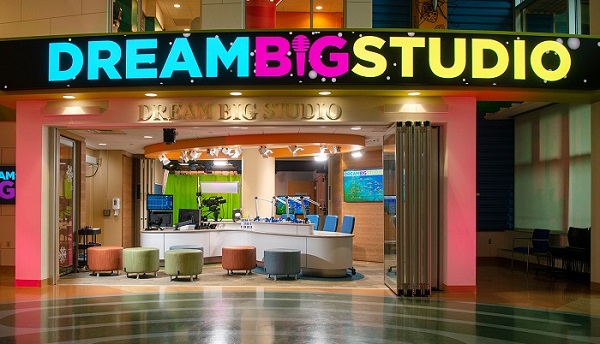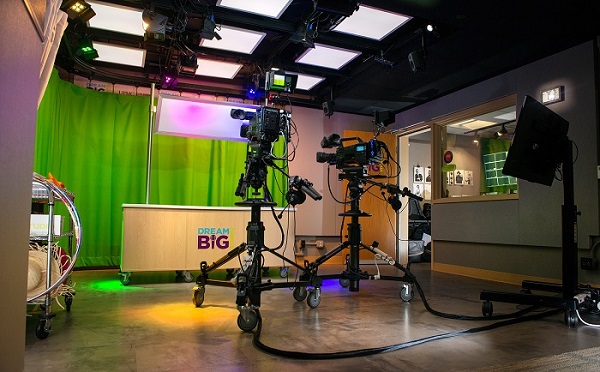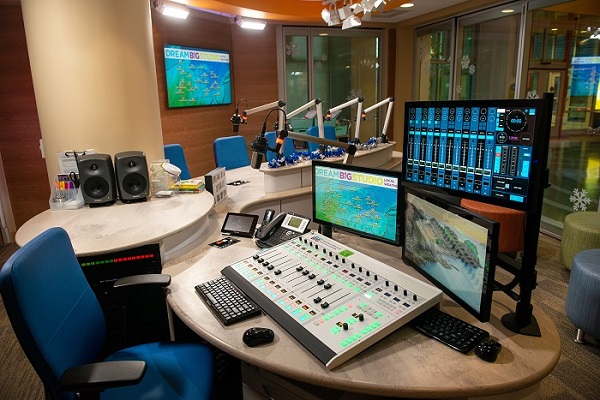
Children’s Hospital delivers a cure for boredom with new Dream Big Studio
A new broadcasting studio at UPMC Children’s Hospital of Pittsburgh is doing just what its name suggests: allowing kids to dream big, whether they’re in the booth or following along from their beds.
The hospital spent about a year building the Dream Big Studio, the brainchild of a former Children’s executive. The $10 million Masterpiece of Hope campaign raised money for the studio and the Nora Grace Kaufman Center for Creative Arts Therapy.
Children’s staffers know that kids can feel isolated and lonely while hospitalized. Making art or music can give them a creative outlet and help them communicate.
“The studio is almost central to our hospital, in terms of inpatient areas. It’s off the atrium, which we use for quite a few events and activities,” says Riley Hammond, the child life specialist coordinator who oversees the studio and its programming. “The intent is for kids to come, be on TV and make TV. It includes a radio side, with an audio board and four talent mics.”
Just like any television studio, this one has a lighting grid system, multiple cameras, teleprompters and a green screen. Live and recorded programming goes to all patient rooms through the closed-circuit system, as well as the emergency department and outpatient areas.
“We have been doing a weekly show, and we’ll continue to ramp that up to where there will be programming five days a week, and eventually, there will be multiple shows a day,” says Hammond. She’s still testing the best times to reach kids with shows; late afternoons seem to work well so far.
The first show was dream themed. Two kids co-hosted with Hammond from the studio and others in hospital rooms received kits to engage them in what was happening. “We decoupaged jars to make them ‘dream jars,’ ” says Hammond. “And as we went, we talked about our dreams, what are the kids’ dreams, or a dream person they’d like to meet on vacation.”
It was an instant hit, with about 90 participants, she says — much more effective than special events that typically draw 15 or 20 kids.
“Our reach is really increasing through this programming,” she says. “A lot of special events, kids can only come if they’re not on isolation precaution or if they don’t have mobility restrictions. There’s a lot of reasons kids have to end up staying in their rooms, so this can reach everybody.”
Another show, about making art out of Bubble Wrap, reached 65 kids. Their hospital room kits included two kinds of Bubble Wrap paper, paints and a paintbrush. The studio hosts that day were two girls, 12 and 15 years old. Hammond pegged the show to National Bubble Wrap Appreciation Day (yes, really).
She has a slew of ideas and, as she develops them, she’ll run them past an advisory board of hospital staff members who will consider such things as target ages and therapeutic goals.
“We’re trying to make sure that we’re meeting the needs of children who are hospitalized and making sure this is accessible to them,” Hammond says. “We’re asking staff to contribute ideas they have, and ultimately we want kids to come up with ideas.”
Kids who don’t take part in shows can still see how the programs are created through backstage tours. When no one is broadcasting live, recorded content can play, including music therapy shows.
“We want to have the majority of content include children,” says Hammond. “Many people have been reaching out since we’ve opened, expressing interest. For instance, PBS has reached out, so we’re interested in seeing whether we can share content that others have produced.”
The studio is much like those developed by the Ryan Seacrest Foundation, but Children’s Hospital wanted theirs to be independent. Funded solely by private donations, it cost $2.7 million to build and has a yearly operating budget of around $30,000 for programming and equipment.
The radio side of the studio hasn’t been used yet, but Hammond envisions interview-style shows, perhaps with a celebrity such as Sidney Crosby and kids asking questions. Others could call in on two working phone lines. The studio also could be used to host song hours or game shows.
Dream Big Studio is open weekdays from 9 a.m. to 5 p.m. Its live shows are listed on a public calendar available on the hospital’s Channel 1.

